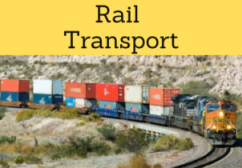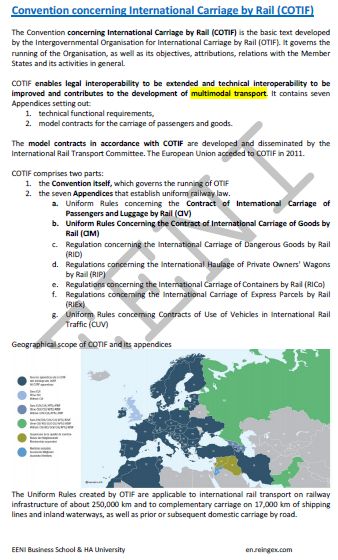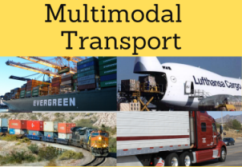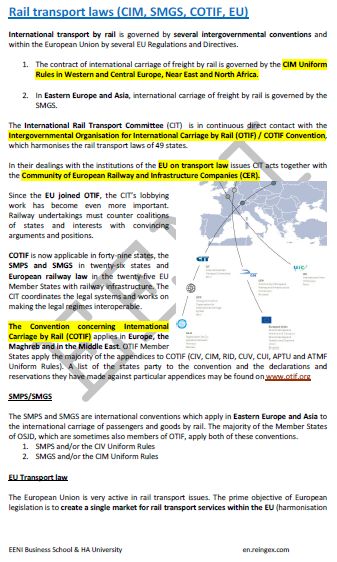COTIF Convention, Transport by Rail (OTIF

Convention concerning International Carriage by Rail (COTIF)
- Introduction to the Intergovernmental Organization for International Carriage by Rail (OTIF). COTIF Convention
- Objectives and areas of activity of the Intergovernmental Organization for International Carriage by Rail (OTIF)
- Convention concerning International Carriage by Rail (COTIF 1999)
- Appendices that establish the uniform railway law
- Uniform Rules concerning the Contract of International Carriage of Goods by Rail (CIM)
- Regulation concerning the International Carriage of Dangerous Goods by Rail (RID)
- Luxembourg Rail Protocol

The Subject “Intergovernmental Organization for International Carriage by Rail (OTIF)” belongs to the following Online Programs taught by EENI Global Business School:
Courses: Rail transport, Multimodal transport, Transport in Africa.

Diplomas: Foreign Trade, International Transport.

Masters: International Transport, Transport in Africa, International Business, Foreign Trade.
Doctorate: Global Logistics, World Trade.
Languages: 
 Convention COTIF (summary in
Convention COTIF (summary in  Organización Transportes Internacionales por Ferrocarril (OTIF)
Organización Transportes Internacionales por Ferrocarril (OTIF)  Convenção COTIF).
Convenção COTIF).
Area of Knowledge: Foreign Trade (International Rail Transport Law).
Intergovernmental Organization for International Carriage by Rail (OTIF).
The Intergovernmental Organization for International Carriage by Rail (OTIF) is the oldest institution related to the international rail transport. Its main objective is to develop an uniform international laws and conventions for the rail transport, as well as to facilitate the rail transport.
Sample - Intergovernmental Organization for International Carriage by Rail (OTIF):


Its most important legal text is the Convention concerning International Carriage by Rail (COTIF) in force since 1999.
- In 2011, the EU (and therefore all its member countries) acceded to the COTIF Convention
- The COTIF Convention contemplates the use of the Multimodal Transport
The most important regulations of the Intergovernmental Organization for International Carriage by Rail (OTIF) are:
- Convention concerning International Carriage by Rail (COTIF 1999)
- Uniform Rules concerning the Contract of International Carriage of Goods by Rail (CIM)
- Luxembourg Rail Protocol
- Regulation concerning the International Carriage of Dangerous Goods by Rail (RID)
Strategic partners of the Intergovernmental Organization for International Carriage by Rail (OTIF):
- Agency of Railways of the EU
- International Committee of the Rail Transport (CIT)
- International Union of Railways
- Organization for Cooperation between Railways (OSJD)
- Economic Commission for Europe
The OTIF also develops agreements on the transport of dangerous goods:
- The OTIF develops its activities in Europe, Africa and Asia
- The OTIF was created in 1893
- Headquarters of the Intergovernmental Organization for International Carriage by Rail (OTIF): Bern (Switzerland)
The member countries of the Intergovernmental Organization for International Carriage by Rail (OTIF) are Albania, Algeria, Armenia, Austria, Azerbaijan, Belgium, Bosnia and Herzegovina, Bulgaria, Croatia, Czech Republic, Denmark, Estonia, Finland, France, Georgia, Germany, Greece, Hungary, Iran, Iraq, Ireland, Italy, Jordan, Latvia, Lebanon, Liechtenstein, Lithuania, Luxembourg, Monaco, Montenegro, Morocco, Netherlands, Macedonia, Norway, Pakistan, Poland, Portugal, Romania, Russia, Serbia, Slovakia, Slovenia, Spain, Sweden, Switzerland, Syria, Tunisia, Turkey, Ukraine, UK.

- Almaty-Bishkek Corridor
- Bangladesh-Myanmar Corridor
- China-Russia Corridor
- China-Pakistan Corridor
- China-Central-West Asia Corridor
- India-Afghanistan Corridor
- Europe-Caucasus-Asia Corridor
- Corridor of the Ashgabat Agreement
- Trans-Siberian Railway (Russia, North Korea)
- North-South Corridor (India-Russia)
- Afghanistan-Turkey Corridor
- Trans-Caspian Corridor
- East-West Corridor (Myanmar-Vietnam)
- Kyrgyzstan-Iran Corridor
- Islamabad-Istanbul Corridor
- Nanning-Singapore Corridor

(c) EENI Global Business School (1995-2024)
We do not use cookies
Top of this page



